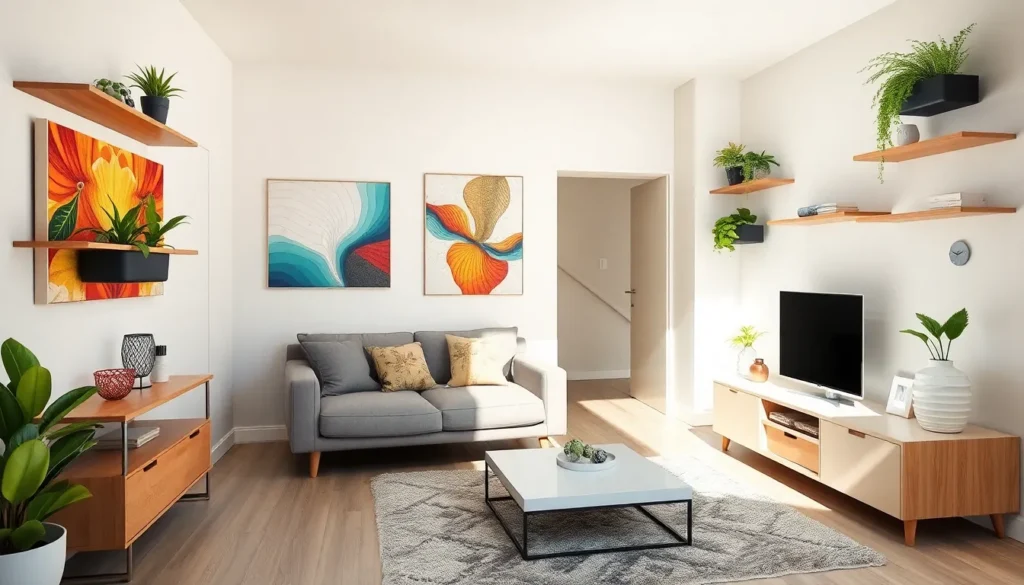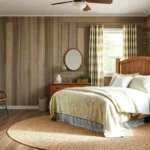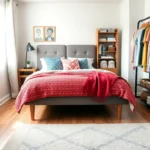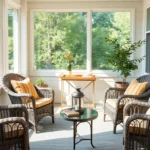Living in a studio apartment doesn’t mean you have to sacrifice style or functionality. We’ve discovered that small spaces can be transformed into stunning homes with the right design strategies and creative answers.
The key to maximizing your studio lies in smart space planning and multi-functional furniture choices. We’ll show you how to create distinct zones for sleeping, working, and entertaining – all within your compact footprint. From clever storage hacks to visual tricks that make rooms feel larger, these proven techniques will help you fall in love with your space.
Whether you’re a first-time renter or downsizing by choice, we’ve gathered the most effective studio apartment ideas that actually work in real homes. Get ready to transform your small space into a stylish sanctuary that feels twice its actual size.
Maximize Your Space With Smart Storage Solutions
Smart storage transforms cramped quarters into organized sanctuaries. We’ll explore three proven strategies that instantly multiply your usable space without expanding your square footage.
Use Vertical Wall Storage
Wall mounted shelves free up valuable floor space while displaying books, plants, and decorative items. Installing floating shelves from floor to ceiling creates visual height and draws the eye upward. We recommend positioning shelves at varying heights to avoid a rigid appearance.
Over door organizers provide instant storage for shoes, cleaning supplies, or bathroom essentials. These affordable answers require no tools and maximize otherwise wasted space behind doors.
Pegboard systems offer customizable storage that adapts to your changing needs. Mount pegboards in kitchens for utensils, in bedrooms for accessories, or near entryways for keys and bags. The modular design lets you rearrange hooks and shelves as your storage requirements evolve.
Invest in Multi-Functional Furniture
Storage ottomans serve triple duty as seating, footrests, and hidden compartments for blankets or magazines. Choose rectangular shapes that can double as coffee tables or extra surface space when entertaining guests.
Lift top coffee tables conceal remotes, board games, and laptop accessories while maintaining a clean living area appearance. The raised surface creates an impromptu workspace for meals or projects without requiring a separate desk.
Expandable dining tables accommodate both intimate dinners and larger gatherings. Wall mounted drop leaf tables fold completely flat when not in use, freeing up precious floor space for daily activities.
Create Hidden Storage Under Your Bed
Platform beds with built in drawers eliminate the need for separate dressers while keeping clothing easily accessible. We suggest choosing platforms with drawers on both sides to maximize storage capacity without increasing the bed’s footprint.
Rolling storage bins slide effortlessly under any bed frame and keep seasonal items or extra linens organized. Clear containers let you identify contents quickly, while wheeled options make retrieval simple even in tight spaces.
Bed risers instantly create additional clearance for larger storage containers or vacuum sealed bags. Raising your bed 6 to 8 inches provides enough space for substantial storage while maintaining easy bed access.
Define Different Areas Using Strategic Room Dividers
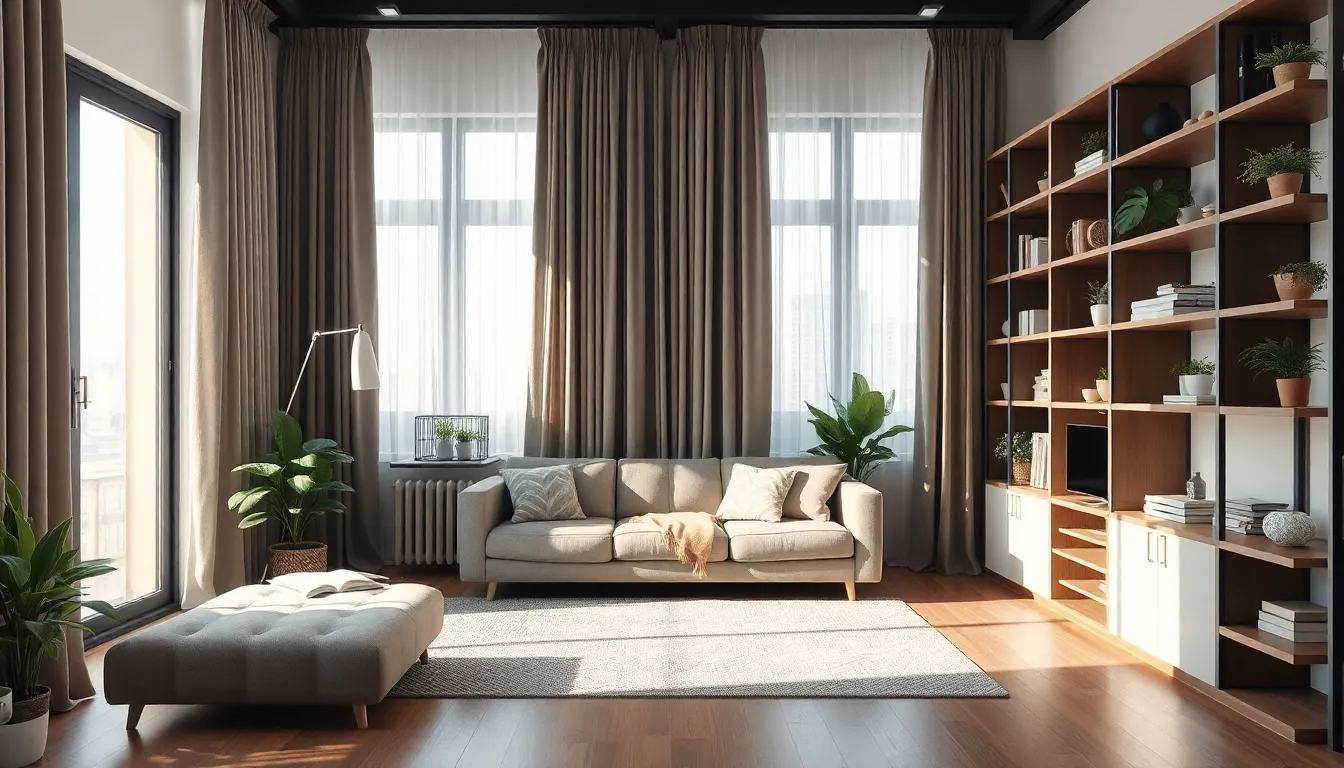
Creating distinct zones within your studio apartment transforms one large room into multiple functional spaces. Strategic room dividers help you establish privacy and organization without permanent walls.
Install Curtains or Sliding Panels
Curtains offer the most flexible approach to dividing your studio space while preserving natural light flow. We recommend hanging floor-to-ceiling panels from tracks mounted to the ceiling for maximum impact. Track systems allow you to easily open or close sections as needed throughout the day.
Sliding panels provide a more structured alternative that maintains clean lines in modern spaces. These panels can feature frosted glass, fabric, or wooden slats depending on your aesthetic preferences. The key advantage lies in their ability to create separation without completely blocking light transmission between areas.
Both options work exceptionally well for separating sleeping areas from living spaces. You can choose heavier fabrics for complete privacy during sleep hours or lighter materials that filter light while maintaining visual connection.
Use Open Shelving Units as Dividers
Open shelving serves dual purposes by creating boundaries while adding essential storage capacity to your studio. We suggest positioning tall bookcases or modular shelving systems perpendicular to walls to naturally separate different zones. This approach maximizes your vertical space while keeping the room feeling open and airy.
Ladder-style shelves work particularly well as room dividers because they maintain visual lightness. You can display books, plants, and decorative objects on the shelves while using the structure to define your living and sleeping areas. The open design prevents the space from feeling cramped or closed off.
Consider shelving units with alternating shelf heights to create visual interest while maintaining functionality. This budget-friendly solution adds extra storage without requiring major renovations or permanent installations.
Position Furniture to Create Natural Boundaries
Strategic furniture placement eliminates the need for additional dividers while maximizing your floor plan efficiency. We recommend positioning your sofa with its back facing the sleeping area to create an instant visual barrier. This arrangement naturally separates your living space from your bedroom zone.
Large furniture pieces like armoires or entertainment centers can anchor different areas when placed strategically. Position these items to block sightlines between spaces while maintaining easy movement throughout the apartment. The goal is creating defined zones without disrupting the natural flow of your daily activities.
Coffee tables and area rugs help reinforce these boundaries by clearly defining each space’s purpose and limits. Place furniture at angles rather than parallel to walls to create more ever-changing room divisions that feel intentional rather than cramped.
Choose Light Colors and Mirrors to Enhance Visual Space

Light colors and reflective surfaces work together to transform cramped studio apartments into bright, spacious sanctuaries. We’ll explore three key strategies that maximize visual space without requiring major renovations.
Paint Walls in Light, Neutral Tones
Paint your walls with light, neutral colors to create an immediate sense of openness in your studio apartment. Light tones reflect natural and artificial light throughout the space, making walls appear to recede and ceilings seem higher. We recommend choosing colors like soft whites, warm beiges, pale grays, or subtle off whites that complement your furniture and decor.
Neutral wall colors reduce visual clutter by creating a cohesive backdrop for your belongings. These versatile shades make your space feel larger while providing flexibility to change accent colors through accessories like throw pillows, artwork, or plants. Light colored walls also enhance the effectiveness of mirrors and other reflective surfaces throughout your studio.
Incorporate Large Mirrors Strategically
Strategically place large mirrors opposite windows to reflect natural light and double the visual impact of your space. Position mirrors where they can capture and bounce light around the room, creating depth and the illusion of additional square footage. We suggest using oversized wall mirrors, mirrored closet doors, or even mirror tiles to maximize this effect.
Mirror placement across from light sources amplifies brightness while making your studio apartment feel significantly more spacious. Consider installing mirrors near your seating area or workspace to reflect activity and create a sense of movement. Large mirrors also serve as functional pieces for getting ready while contributing to your overall design aesthetic.
Select Light Colored Furniture and Decor
Choose light colored furniture and decor pieces to maintain the open, airy feeling you’ve created with your wall color choices. Light furniture helps sustain a sense of visual continuity throughout your studio apartment without overwhelming the limited space. We recommend selecting pieces in whites, creams, light woods, or pale pastels that complement your neutral wall palette.
Light colored furniture creates less visual weight than dark pieces, allowing your studio to feel more spacious and less cluttered. Incorporate light fabrics for curtains, throw pillows, and upholstery to reinforce this bright, open atmosphere. These color choices work together with your mirrors and wall colors to create a cohesive design that maximizes every inch of your studio apartment.
Optimize Your Kitchen Area for Maximum Efficiency
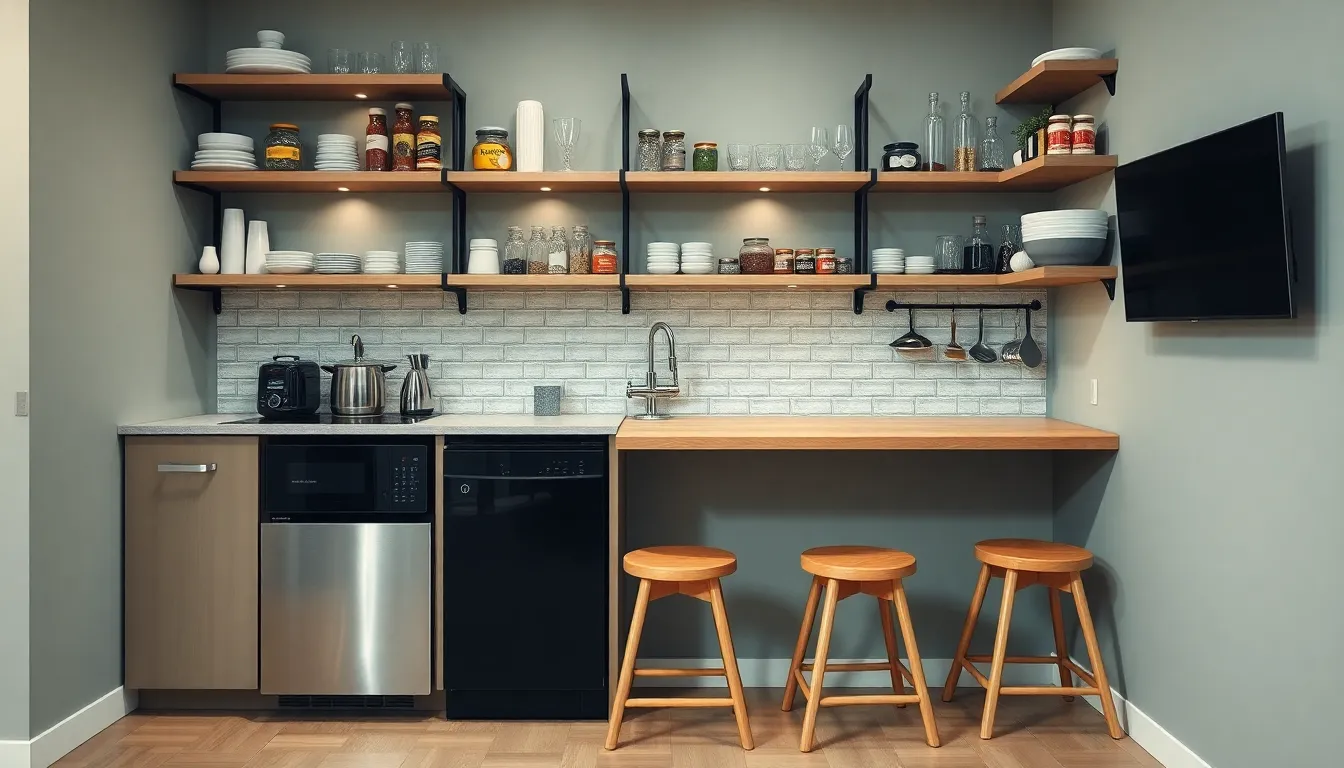
Small kitchens demand smart answers that maximize every square inch of available space. We’ll transform your compact cooking area into a highly functional workspace using these proven efficiency strategies.
Install Wall-Mounted Shelves and Hooks
Wall-mounted shelves provide additional storage without taking up counter or floor space, making them essential for studio apartment kitchens. Mount floating shelves above your sink area to store dishes, glasses, and frequently used items within easy reach. Install magnetic spice racks on the side of your refrigerator to keep seasonings organized and accessible.
Hooks transform vertical wall space into practical storage for cooking utensils, measuring cups, and dish towels. We recommend installing a rail system beneath your upper cabinets to hang everything from spatulas to coffee mugs. Consider adding adhesive hooks inside cabinet doors to maximize storage for lightweight items like oven mitts and small tools.
Use Compact, Space-Saving Appliances
Compact appliances reduce clutter and increase efficiency by fitting perfectly into tight kitchen spaces. Choose a slim dishwasher that’s 18 inches wide instead of the standard 24-inch model to save precious counter space. Select a combination microwave and convection oven to eliminate the need for separate appliances.
Mini fridges with freezer compartments work well for single occupants or couples who shop frequently for fresh ingredients. We suggest investing in stackable appliances like a compact washer and dryer unit that fits in a kitchen closet. Look for appliances with multiple functions, such as a toaster oven that also air fries and dehydrates food.
Create a Fold-Down Dining Table
Fold-down tables create a dining area when needed without permanently occupying valuable floor space in your studio. Mount a wall-mounted drop-leaf table that folds flat against the wall when not in use, instantly freeing up your kitchen for cooking and movement. Install the table at counter height to double as additional prep space during meal preparation.
We recommend choosing a table with built-in storage compartments for placemats, napkins, and dining essentials. Position fold-down stools or chairs underneath the table that slide completely out of sight when folded. Consider adding a small shelf beneath the table surface to hold dishes or decorative items that enhance your kitchen’s style.
Design a Comfortable Sleeping Area That Doubles as Living Space
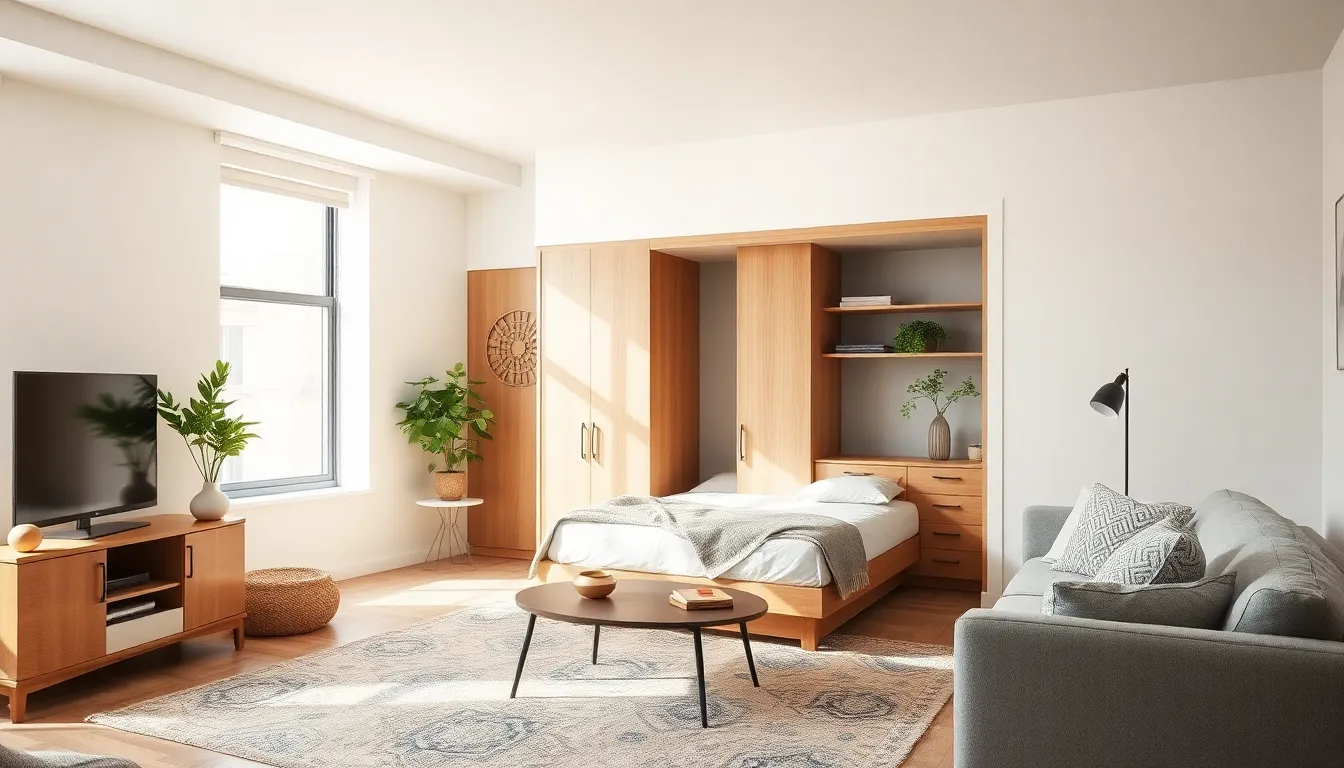
Creating a sleeping area that seamlessly transforms into living space maximizes every square foot of your studio apartment. We’ll show you how to achieve this dual functionality through smart furniture choices and strategic positioning.
Consider a Murphy Bed or Daybed
Murphy beds revolutionize studio living by folding up against the wall or into a cabinet when not in use. We can reclaim valuable floor space during the day for activities like yoga, entertaining guests, or simply moving around more freely. These wall-mounted beds enable your room to serve multiple daily functions without compromising comfort.
Daybeds offer another versatile solution by providing comfortable seating during the day and sleeping space at night. We love how daybeds blend living and sleeping functions seamlessly, eliminating the need for separate furniture pieces. Consider models with built-in trundles or storage drawers underneath to maximize their utility in your compact space.
Both options deliver the flexibility we need to transform our studio from bedroom to living room within minutes. Murphy beds work particularly well in studios with high ceilings, while daybeds suit spaces where we want permanent seating that doesn’t look like a traditional bed.
Use Platform Beds With Built-In Storage
Platform beds with integrated storage maximize space efficiency while reducing clutter in our sleeping area. We can choose designs with drawers underneath to store bedding, clothing, or seasonal items without adding bulky dressers or wardrobes to our studio.
Built-in storage keeps our sleeping area uncluttered and maintains clean sight lines throughout the space. We recommend selecting platform beds with open shelving underneath for frequently accessed items like books, electronics, or decorative objects. This approach eliminates the need for additional nightstands or storage furniture.
Storage platform beds come in various heights to accommodate different storage needs. We can opt for higher platforms to fit larger storage bins or lower profiles for a more minimalist look while still gaining valuable storage space beneath our mattress.
Position Your Bed to Define the Bedroom Zone
Strategic bed placement creates clear visual separation between sleeping and living areas without closing off the space entirely. We position beds against walls with low bookshelves or half walls to mark boundaries while maintaining an open layout throughout our studio.
Area rugs help define the bedroom zone by creating a distinct visual and textural boundary around our sleeping area. We use contrasting or complementary rugs to separate the bedroom from living spaces while tying the overall design together through coordinated colors or patterns.
Furniture placement naturally defines boundaries when we position our bed alongside room dividers like open shelving units or screens. We can place the bed at an angle or use strategic furniture groupings to create intimate sleeping quarters that still feel connected to the rest of our living space.
Light colors in our bedroom zone make the entire studio feel more spacious and inviting. We paint accent walls behind our beds or use light-colored bedding and decor to enhance both sleeping and living areas while maintaining visual cohesion throughout our compact home.
Incorporate Flexible Lighting to Set Different Moods

Lighting flexibility transforms your studio apartment into a ever-changing living space that adapts to your daily activities and personal preferences. We’ll show you how strategic lighting choices can create the perfect ambiance for any moment.
Layer Ambient, Task, and Accent Lighting
Ambient lighting provides the foundation for your studio’s overall illumination, creating a comfortable base level throughout the space. We recommend combining this with task lighting that focuses on exact activities like reading, cooking, or working at your desk. Accent lighting adds the final layer by highlighting artwork, architectural features, or decorative elements that showcase your personal style.
This three-layer approach works exceptionally well in studio apartments where you need adaptable lighting for multi-purpose living areas. Task lighting ensures you have adequate brightness for detailed work without overwhelming the entire space. Accent lighting creates visual interest and depth, making your compact home feel more sophisticated and welcoming.
Use Floor and Table Lamps Instead of Overhead Fixtures
Floor and table lamps offer superior mobility compared to fixed overhead fixtures, allowing you to position light exactly where you need it most. We suggest choosing lamps that can move between different zones of your studio as your activities change throughout the day. Portable lighting gives you the freedom to create cozy reading nooks, well-lit workspaces, or intimate dining areas within the same compact footprint.
Plug-in wall sconces and picture lights provide additional flexibility without requiring permanent electrical work or professional installation. Low-hanging pendant lights can define exact areas while remaining adjustable for your changing needs. These moveable options maximize both comfort and style in small-space living.
Install Dimmer Switches for Versatility
Dimmer switches enable easy adjustment of light intensity, creating seamless transitions from bright daytime illumination to softer evening moods. We recommend installing dimmers on your primary light sources to cultivate the perfect atmosphere for any activity or time of day. This simple upgrade allows you to customize your studio’s ambiance without purchasing additional fixtures or lamps.
Brightness control becomes especially valuable in studio apartments where your living, sleeping, and working areas share the same space. Dimming capabilities help you maintain appropriate lighting levels for relaxation while preserving the option for task-focused brightness when needed.
Add Personality With Vertical Decor and Wall Art
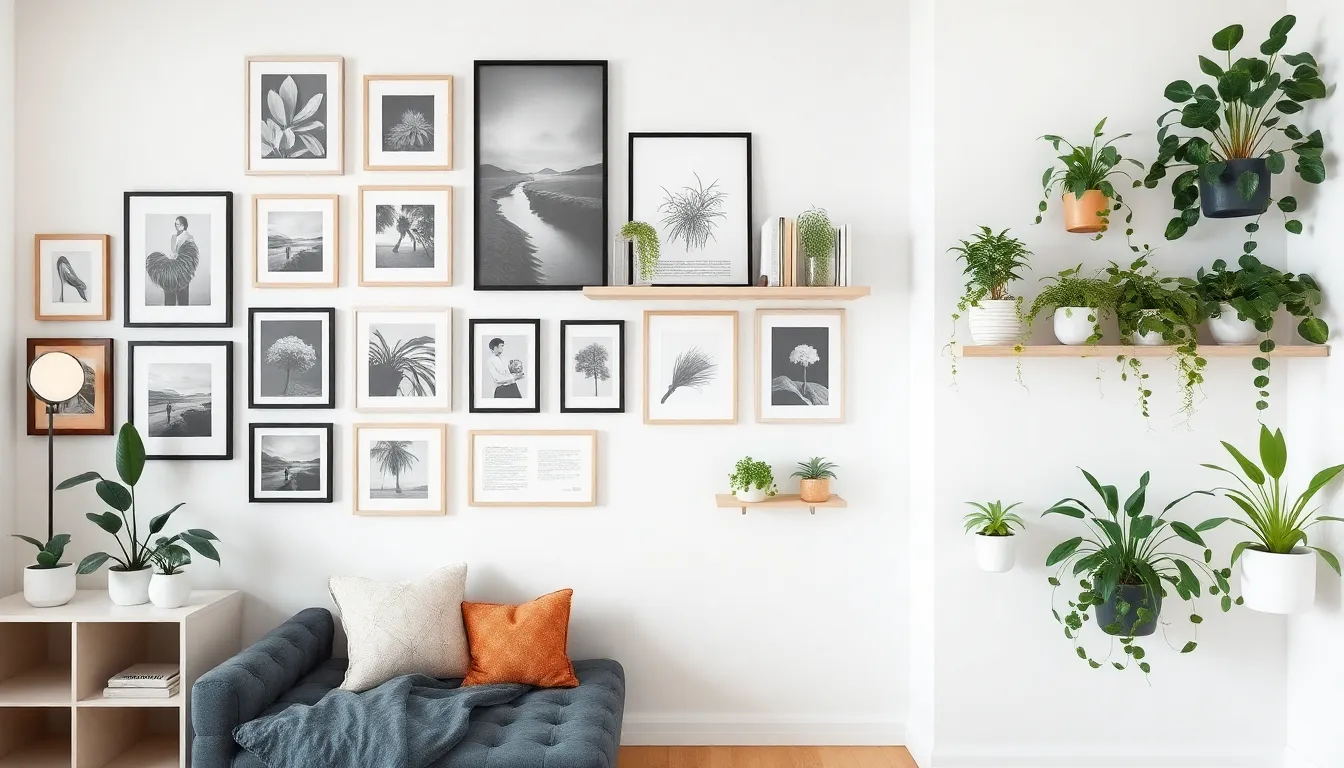
Vertical decor transforms studio apartments by drawing attention upward and creating the illusion of more space. Strategic wall art placement makes ceilings appear higher while adding personality to your living area.
Create Gallery Walls to Draw Eyes Upward
Gallery walls serve as powerful focal points that make studio apartment ceilings appear significantly higher. Arrange multiple pieces of artwork in varying sizes from floor to ceiling, creating a dramatic vertical display that guides the eye upward. Mix framed photos, prints, and small mirrors to add visual interest while maintaining cohesion through consistent frame colors or themes.
Position your gallery wall on the longest uninterrupted wall space to maximize impact. Start by laying out your arrangement on the floor before hanging to ensure proper spacing and balance. Leave 2-3 inches between each piece to prevent the display from feeling cluttered while maintaining visual flow.
Use Floating Shelves for Display
Floating shelves provide elegant storage and display options without consuming valuable floor space in your studio. Install them at varying heights to create visual rhythm while showcasing books, plants, and decorative objects. Choose shelves in light wood tones or white finishes to maintain the airy atmosphere you’ve established with your color scheme.
Arrange items in odd numbers and vary heights for the most pleasing visual effect. Group books with small plants or candles to create mini vignettes that add personality without overwhelming your space. Keep displays minimal and rotate items seasonally to maintain fresh visual interest.
Incorporate Plants and Greenery on Walls
Wall mounted planters and hanging gardens bring life to vertical spaces while maintaining your studio’s open floor plan. Install wall planters at different heights to create a living gallery that adds depth and natural beauty to your apartment. Choose low maintenance plants like pothos, spider plants, or air plants that thrive in various lighting conditions.
Create a green wall feature using modular planting systems that can expand as your collection grows. Position plants near windows to take advantage of natural light while using grow lights for shadier wall areas. This approach adds organic texture and improves air quality while reinforcing the sense of openness you’ve worked to achieve throughout your studio.
Organize Your Belongings With Designated Zones
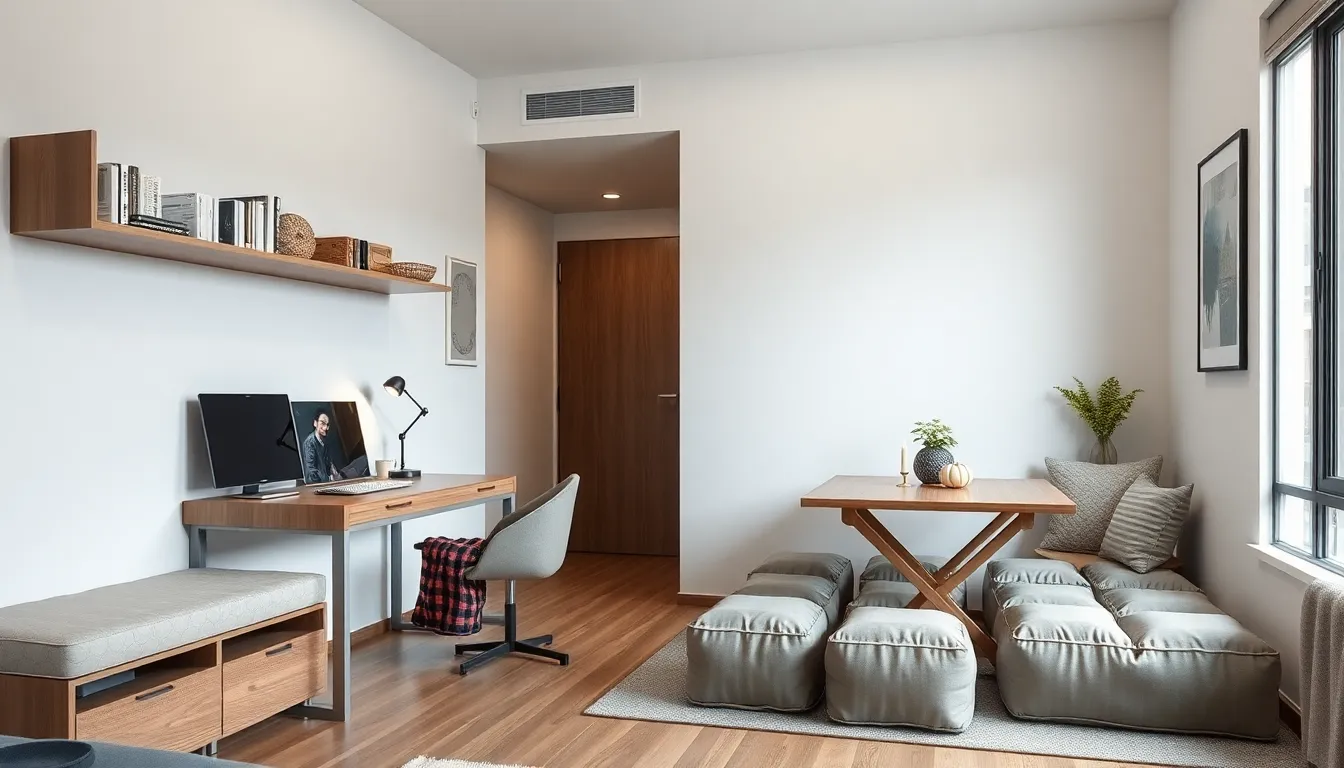
Establishing exact zones for different activities helps maintain organization while maximizing functionality in your studio space. We’ll show you how to create purposeful areas that keep your belongings organized and easily accessible.
Create a Dedicated Work Station
Multi-functional furniture serves as the foundation for an efficient workspace. Invest in a desk with built-in storage compartments or consider a Murphy bed with an attached desk that folds away when not needed. Wall-mounted desks also work well in tight spaces, providing a work surface without taking up floor area.
Room dividers help separate your workspace from living areas. Position a tall bookshelf behind your desk to create visual separation while adding storage for office supplies and books. Alternatively, use a folding screen or curtain panel to define your work zone and minimize distractions during productive hours.
Vertical storage keeps your desk clutter-free. Mount floating shelves above your workspace for frequently used items like notebooks and charging stations. Pegboard systems offer customizable organization, allowing you to hang tools, supplies, and inspiration boards within arm’s reach.
Establish an Entryway Area
Entryway organizers prevent clutter from spreading throughout your studio. Place a storage bench near your entrance to provide seating while hiding shoes, bags, and seasonal accessories. Choose benches with lift-up tops or built-in cubbies for maximum organization potential.
Vertical hooks maximize wall space for hanging items. Install a row of wall hooks at varying heights to accommodate jackets, bags, and keys. Over-the-door organizers work well for renters, providing shoe storage and small item compartments without permanent installation.
Shoe racks keep footwear organized and accessible. Select a slim shoe rack that fits against the wall or opt for a tiered design that accommodates multiple pairs in a compact footprint. Under-bench shoe storage combines seating with organization, making the most of your entryway real estate.
Design a Exact Dining Space
Compact dining tables adapt to your space requirements. Choose a foldable table that mounts to the wall and drops down when needed, or select an extendable model that adjusts based on your dining needs. Round tables work well in small spaces, eliminating sharp corners while accommodating more people.
Storage ottomans provide dual-purpose dining answers. Use cushioned ottomans as extra seating during meals and storage for table linens, placemats, and serving pieces. These versatile pieces can move around your studio as needed, supporting various activities beyond dining.
Wall-mounted answers keep dining essentials organized. Install floating shelves near your dining area for dishes, glasses, and serving pieces. Consider a fold-down bar table that attaches to the wall, creating an instant dining surface that disappears when not in use.
Conclusion
We’ve explored comprehensive strategies that can transform your studio apartment from cramped quarters into a stylish and functional home. These design principles work together seamlessly—when you combine smart storage with strategic lighting and thoughtful zoning you’ll create a space that feels significantly larger than its actual square footage.
The key lies in viewing every element as an opportunity for dual purpose. Whether it’s a Murphy bed that creates daytime living space or vertical storage that draws the eye upward these answers maximize both function and visual appeal.
Remember that successful studio living isn’t about having less—it’s about being more intentional with what you choose to include. With these proven techniques you can create a home that reflects your personality while meeting all your daily needs in one beautifully organized space.
Frequently Asked Questions
What are the best storage solutions for studio apartments?
The most effective storage solutions include utilizing vertical wall space with mounted shelves and pegboard systems, investing in multi-functional furniture like storage ottomans and lift-top coffee tables, and maximizing under-bed storage with platform beds featuring built-in drawers or rolling storage bins. These strategies help free up floor space while keeping belongings organized.
How can I create separate zones in my studio apartment?
Use strategic room dividers such as curtains, sliding panels, or open shelving units to establish distinct areas while preserving natural light. Position furniture like sofas and large pieces to create natural boundaries between sleeping, working, and living spaces without obstructing movement throughout the apartment.
What colors and design elements make studio apartments look bigger?
Light, neutral wall colors reflect natural light and create a sense of openness. Incorporate large mirrors strategically to amplify brightness and create the illusion of additional square footage. Choose light-colored furniture and decor to maintain an airy atmosphere and maximize the visual space in your studio.
How do I optimize my studio apartment kitchen for maximum efficiency?
Install wall-mounted shelves and hooks for additional storage without using counter space. Choose compact, space-saving appliances to reduce clutter. Consider a fold-down dining table mounted to the wall that can be stored when not in use, creating more functional workspace in your kitchen area.
What are the best bed options for studio apartments?
Murphy beds that fold up against the wall reclaim floor space during the day. Daybeds provide versatile seating and sleeping options. Platform beds with built-in storage help reduce clutter while maintaining comfort. Strategic placement with area rugs helps create visual separation between sleeping and living areas.
How should I approach lighting in my studio apartment?
Use a three-layer lighting approach with ambient, task, and accent lighting. Incorporate moveable floor and table lamps for customizable arrangements. Install dimmer switches to adjust light intensity for different activities and times of day, creating a comfortable and adaptable atmosphere throughout your space.
What vertical decor strategies work best in small spaces?
Create gallery walls that draw the eye upward using a mix of artwork and mirrors. Install floating shelves for elegant storage and display options. Use wall-mounted planters and hanging gardens to add greenery without taking up floor space, enhancing both visual interest and the sense of openness.
How do I organize different functional zones in my studio?
Create a dedicated workspace with multi-functional furniture like wall-mounted desks. Establish an organized entryway with storage benches and vertical hooks. Use compact, adaptable dining tables with storage ottomans. Room dividers like tall bookshelves can visually separate areas while maintaining an open feel throughout the space.

